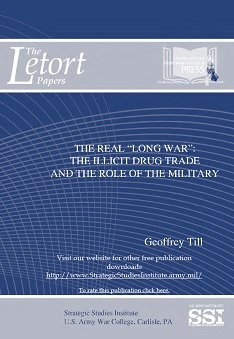Autor: México Unido Contra la Delincuencia
Consideramos que Terminando la guerra contra las drogas: cómo ganar el debate en América Latina constituye un recurso sin lugar a dudas singular. Por un lado, es producto de los más de 15 años de experiencia de la Transform Drug Policy Foundation en la realización de campañas de incidencia política para impulsar la reforma y contribuir al debate — principalmente a través de publicaciones como Herramientas para el Debate y Después de la guerra contra las drogas: una propuesta para su regulación — y por otro, se funda en los 15 años de experiencia de México Unido Contra la Delincuencia en el conocimiento práctico de la realidad latinoamericana y sus desafíos en materia de seguridad ciudadana. Finalmente, esta guía se nutre también de la invaluable contribución de un grupo de expertos de política de drogas y del apoyo de muchos otros grupos y colegas de América Latina.
By: Kasia Malinowska-Sempruch & Olga Rychkova, edited by Open Society Foundation
In the public mind, the “war on drugs” probably conjures up a male image. In most countries, official statistics would show that men, indeed, are the majority of people who use drugs recreationally, who have problematic use, and who sell drugs. But punitive drug laws and policies pose a heavy burden on women and, in turn, on the children for whom women are often the principal caregivers. Men and boys are put at risk of HIV and hepatitis C by prohibitionist policies that impede access to and use of prevention and care services, but women and girls virtually always face a higher risk of transmission of these infections. Men suffer from unjust incarceration for minor drug offenses, but in some places women are more likely than men to face harsh sentences for minor infractions. Treatment for drug dependence is of poor quality in many places, but women are at especially high risk of undergoing inappropriate treatment or not receiving any treatment at all. All people who use drugs face stigma and discrimination, but women are often more likely than men to be severely vilified as unfit parents and “fallen” members of society.
In common with the military establishments in most of the world’s other countries, the U.S. military faces two challenges. The first of these is to decide strategic priorities in the aftermath of the Iraq and Afghanistan wars and the likely de-emphasis on preparation for large-scale counterinsurgency missions. The second connected challenge is the balance to be struck between traditional military functions and the “newer” nontraditional ones. Of course, the deterrence and prevention of war will remain the top priority for the U.S. military as for most others, and thus the maintenance of the capacity to “fight and win” so far as resources will allow, remains a non-negotiable requirement.
By: On the Wagon
Illicit drug use is estimated to cost $193 billion a year with $11 billion just in healthcare costs alone.
OnTheWagon was founded by victims of drug and alcohol abuse with the objective of creating the most comprehensive and authoritative resource for parents, children, friends, and society as a whole on drug abuse and mental health related issues, with the end goal to get them back “on the wagon.” This goal accomplished via the dissemination of substance abuse information and advocate healthy life choices by using free, integrated social media, web-based campaigns, and experts in the field.
These campaigns consist of substance abuse prevention messages that intend to change attitudes, and ultimately, behaviors.
Table of Contents
- Drug Information
- Drug Classes
- Amphetamines
- Cocaine/Crack
- Designer Drugs
- Ecstasy
- Herbal Ecstasy
- Heroin
- Inhaled Household Products
- LSD
- Marijuana
- Mushrooms
- PCP
- FAQs about Drugs
- Rethinking Drinking
- Resources For Students
- Reducing Alcohol & Drug Usage on Campuses
- Further Resources & Available Help
- Resources For Addiction Help By State
- Intervention Services
Further information, click here
Autores: Ryan S. King y Marc Mauer
Fecha: Mayo 2005
Fragmento del original: In order to provide a framework for assessing the role of marijuana enforcement in the criminal justice system, we have conducted a national analysis of marijuana offenders for the period of 1990 to 2002. This includes an assessment of trends in arrest, sentencing, and incarceration, along with an evaluation of the impact of these developments on marijuana price and availability, and the use of crime control resources. Our analysis indicates that the “war on drugs” in the 1990s was, essentially, a “war on marijuana.




